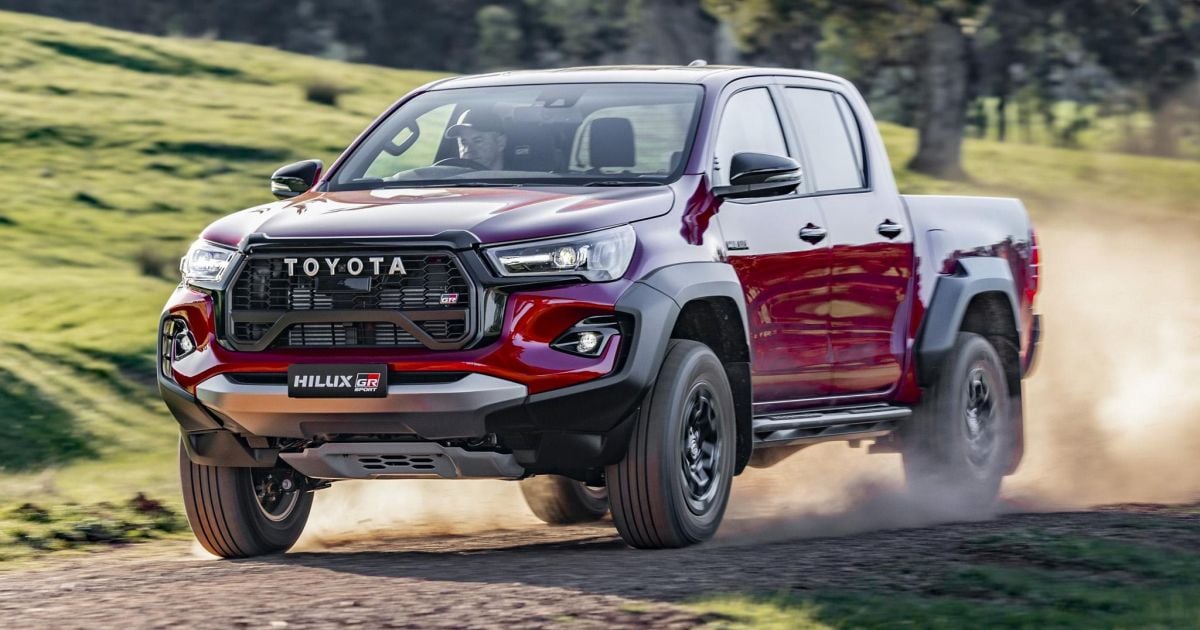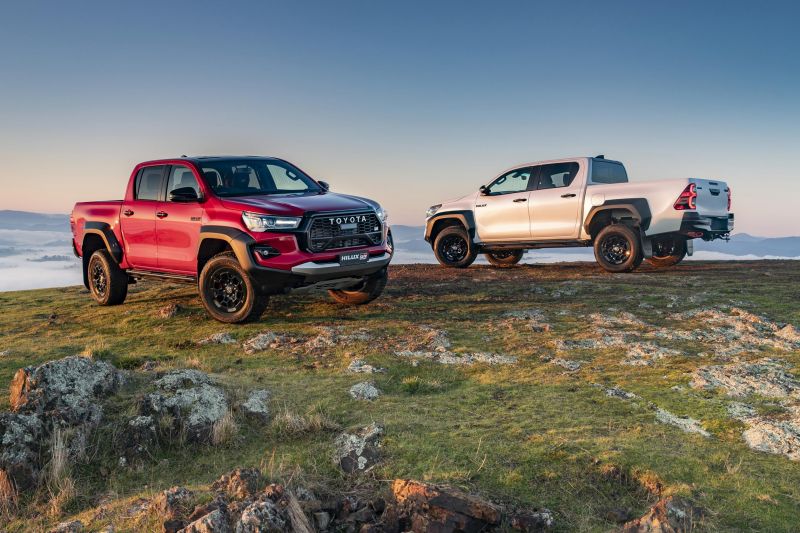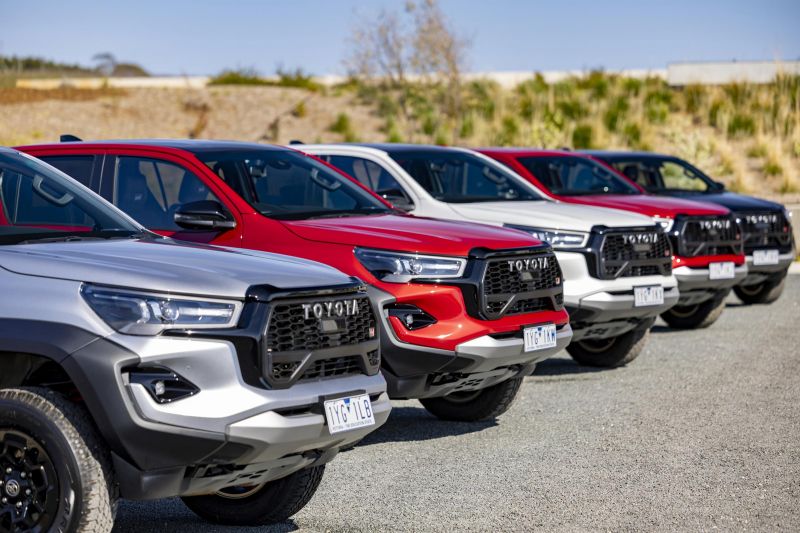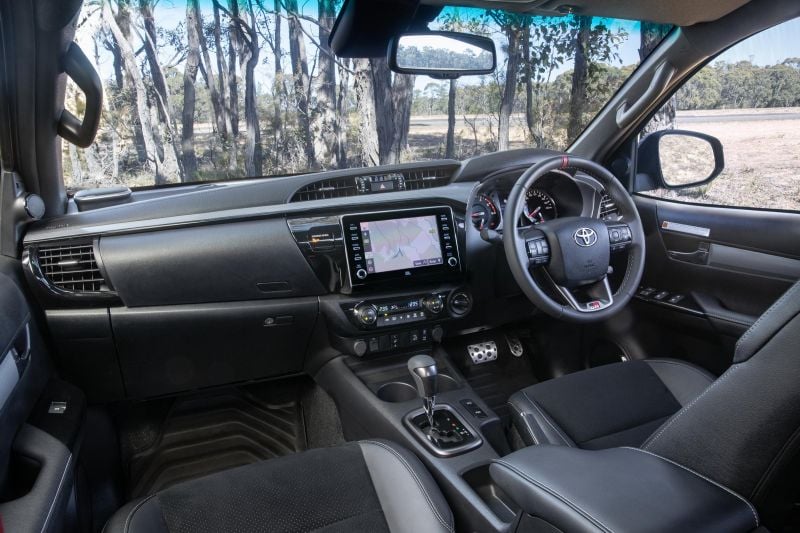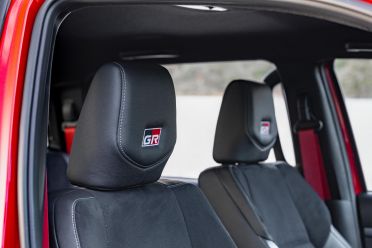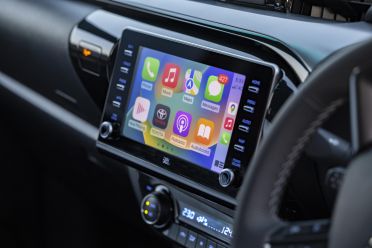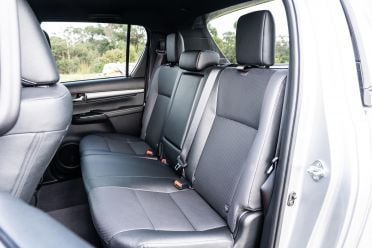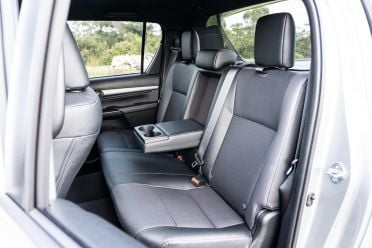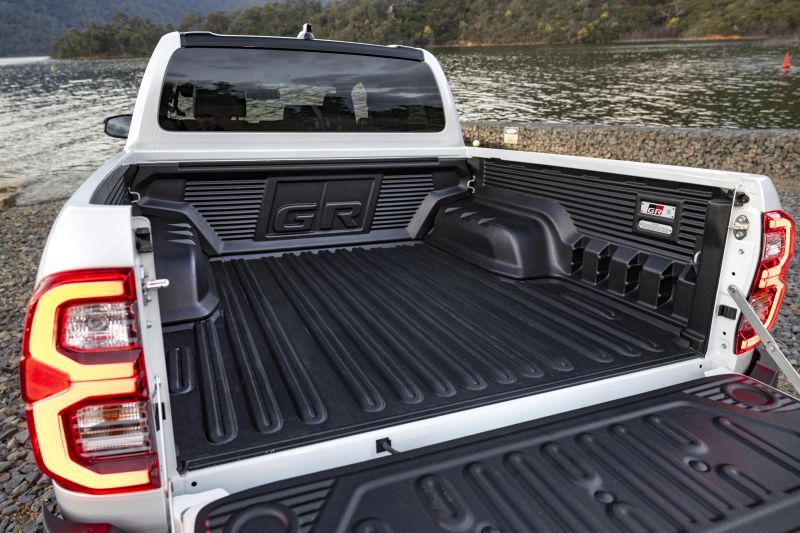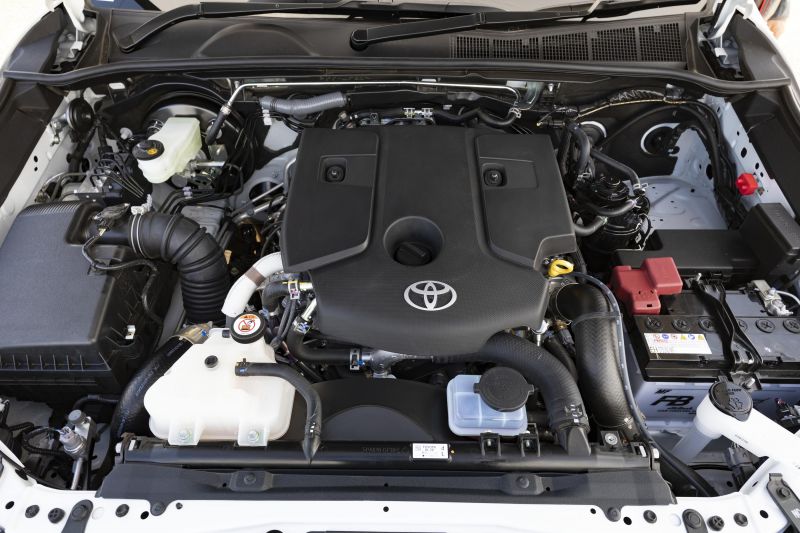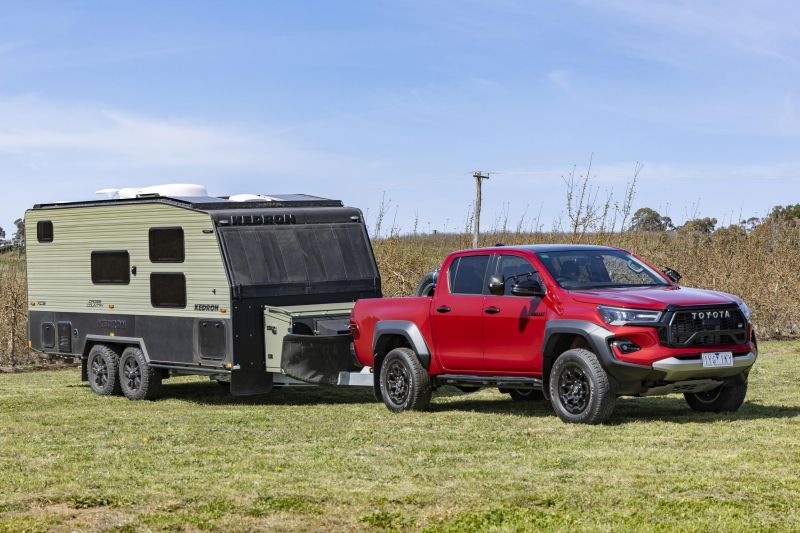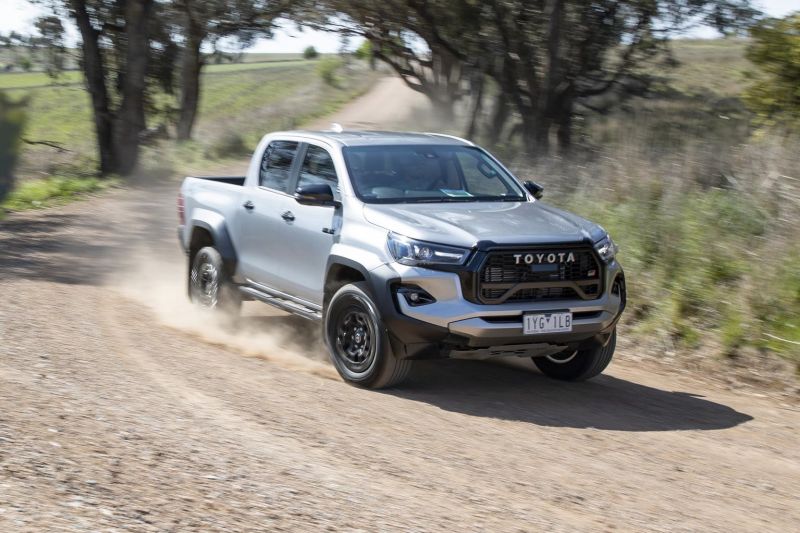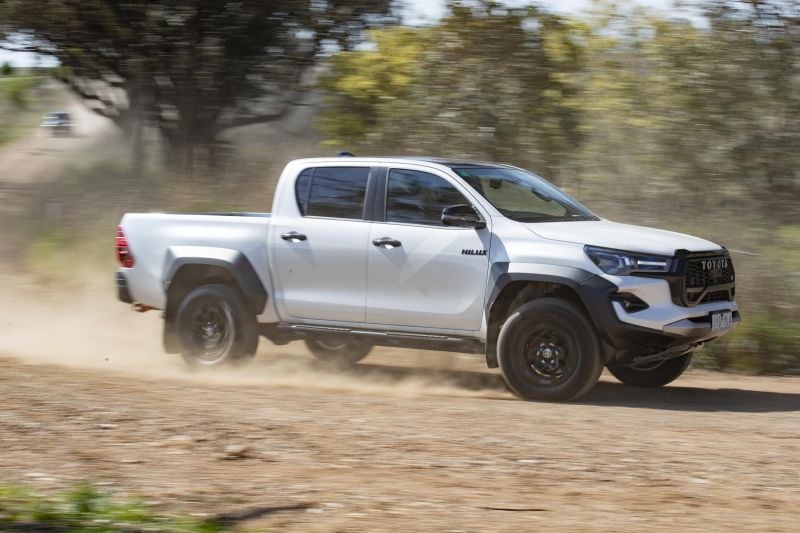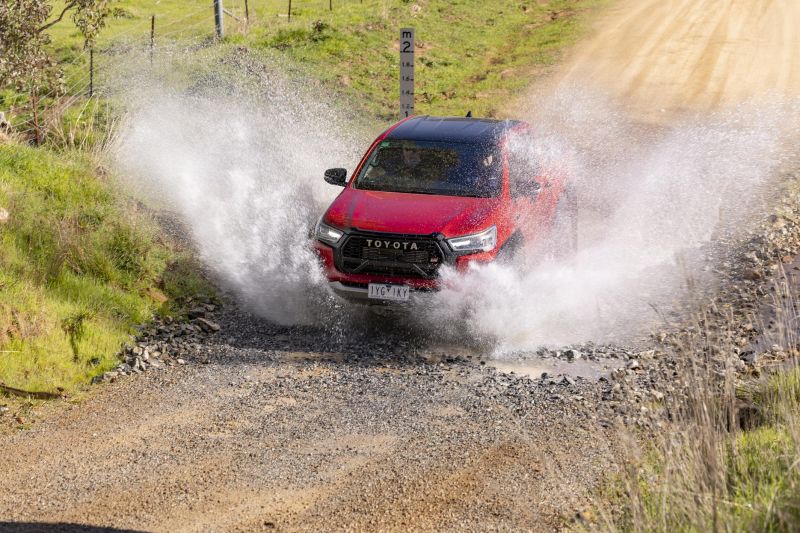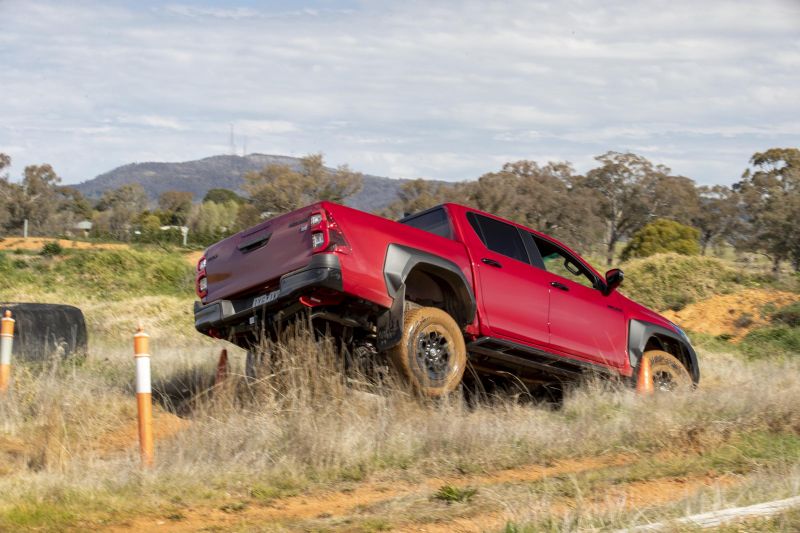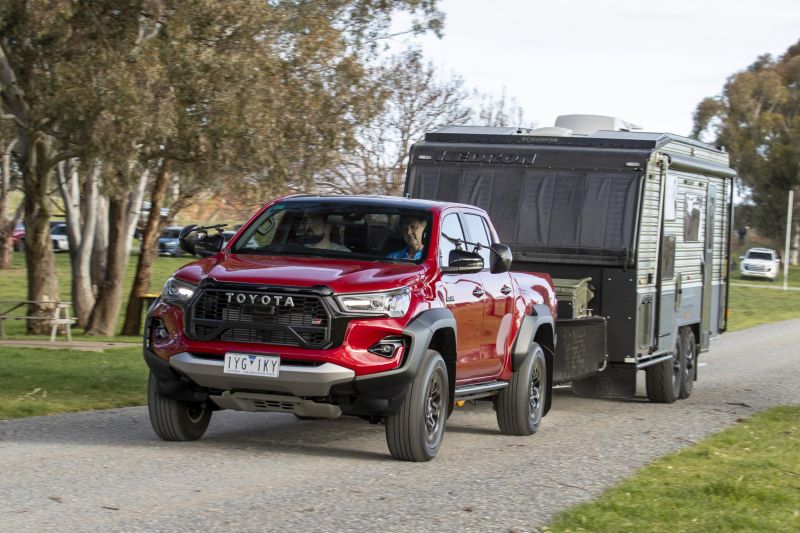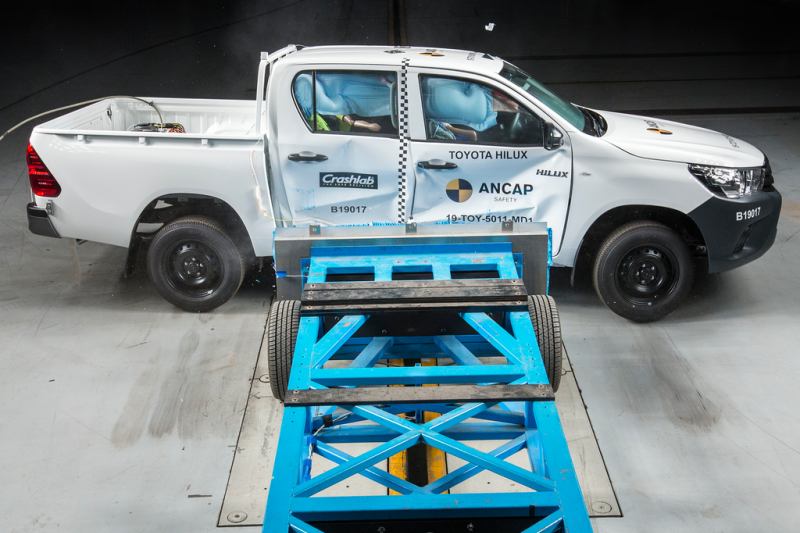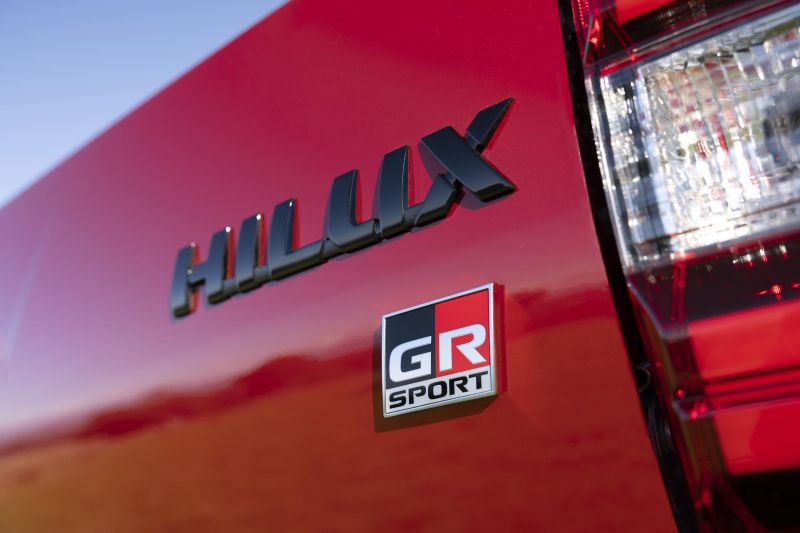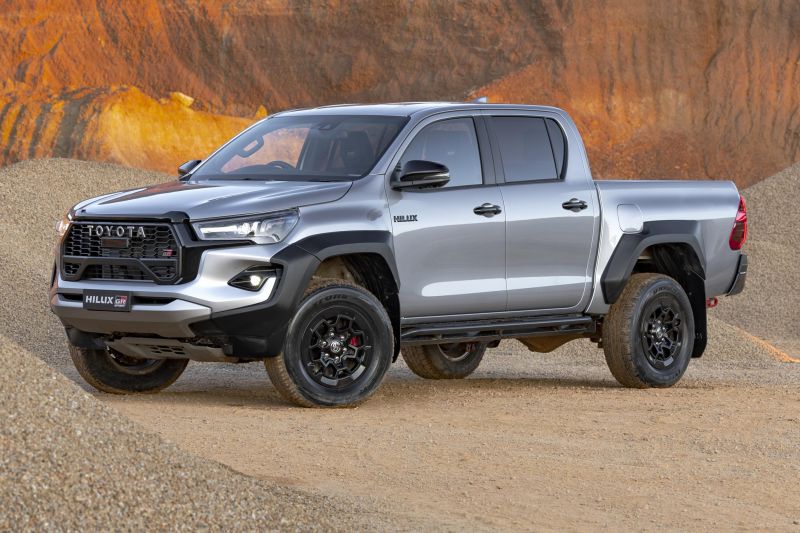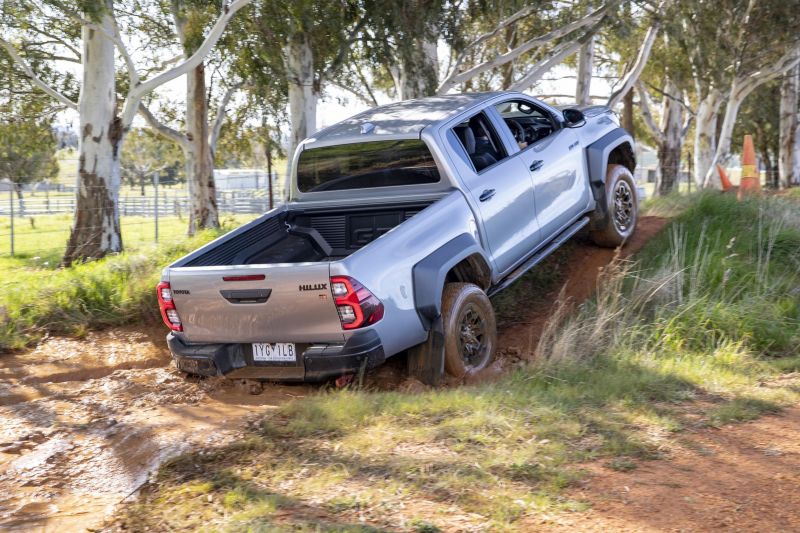Don’t call it a Ranger Raptor rival. That’s not what this is supposed to be.
That’s according to Toyota Australia, which did most of the work on this new top-spec take on the current-gen HiLux theme.
The Toyota HiLux GR Sport is the result of an Australian-led design and development program with the aim of instilling the essence of the Dakar Rally-winning HiLux truck into something a regular customer could buy.
Honestly, that seems a tad far-fetched, but the designers have showcased some cues that help you connect the two in your mind.
With its big-foot underpinnings shared with the Rogue model, a new look, more power and torque, a revised auto gearbox with paddle-shifters, four-wheel disc brakes, revised KYB shocks, and some interior trim revisions, there’s a bit that has changed.
But in a lot of ways, this is just a new take on an old ute.
How much does the Toyota HiLux cost?
It’s the most expensive Toyota HiLux in this generation, at $73,990 before on-road costs. But unbelievably, that’s not overly expensive for a dual-cab ute these days!
I mean, it’s not affordable for a lot of people, but considering the changes made to this version of the HiLux, there’s plenty of value on offer here.
For context, that $74k list means it is a few thousand dollars more expensive than the existing flagship Rogue, which is now $70,760 before on-roads.
But for even more context, the GR Sport version of the HiLux is very closely priced to the following utes:
All prices exclude on-road costs.
But if you’re on a budget and want a serious off-road dual-cab ute, there’s also the GWM Ute Cannon-XSR, which is a bargain beast at $52,990 drive-away.
Changes to the GR Sport over an SR5 are extensive.
It rides on the wider track layout of the Rogue, with an additional 135mm of width at the front axle and 155mm at the rear, and Toyota says the over fender arch flares allow customers to upsize their wheel and tyre package, which should mean you won’t get fined if you fit a set of 33-inch muddies.
Standard rubber is a set of 265/65R17 Bridgestone Dueler all-terrain tyres, with gloss-black, model-specific 17-inch alloy wheels. Plus, it rides 15mm taller than most other HiLuxes, too.
There are new KYB monotube shock absorbers, the rear stabiliser bar has been deleted for better off-road-ability, there are four-wheel disc brakes, and the front-end has seen a distinctive new-look bumper and grille fitted.
The bumper incorporates aerodynamic elements to help it push through the air better – but if you’re the sort of person who prefers a ‘frontal protection bar’ (formerly known as a bull bar), then Toyota has such an option for you from its in-house accessories catalogue.
There’s also a locally-developed, “Dakar-inspired” front skid plate, rock-rails along the sills, and 20mm steel rear recovery points, painted red for extra visibility. And there is a standard-fit towbar with a tow ball and seven-pin wiring harness. If you want an electronic trailer brake controller, you will need to pay extra.
And there are some interior changes too…
What is the Toyota HiLux like on the inside?
Right, if you are expecting huge changes you’re going to be left disappointed. Unless you consider red seat belts to be a big change…
There are some meaningful adjustments to the cabin, including a new set of GR Sport seats trimmed in suede and fake leather, with additional bolstering compared to the seats in other models. They have GR embroidery on the headrests, and there’s contrast light stitching for the seats, armrests, and steering wheel.
The tiller is a GR unit with a red straight-ahead marker, leather grabby bits, but the same styling as a standard HiLux in terms of button placement. Yep, still a cruise control stalk, too.
The rear seat trim matches the fronts, you get a dark headliner, and there are new plastic trim designs on the doors, dashboard, and gear selector surround.
Otherwise? It’s a top-spec HiLux inside. The changes do make it feel more special than a standard model, but not nearly as up-scale as some new rivals like the Amarok and Ranger, which have shifted the game significantly.
That means you still get that same old media unit – albeit with a new skin design and red graphics that are a bit easier to get to terms with. The old stacked menu setup has made way for a better, more smartphone-like icon layout, and that helps.
And it’s also good to see that you’ve got knobs and buttons to control the main functions of the media system, though – as with plenty of other Toyota products – some of the stuff you’d like to be able to do while you’re driving, you can’t, like type in a phone number or address in the mapping system of your choice.
There are even a few settings you can’t adjust while driving. I guess it’s designed to make you use voice control.
There is dual-zone climate control, single-stage seat heating for the front seats (it’s on, or it’s off) and the driver’s seat features electric adjustment, while the passenger’s seat is still manual.
The space hasn’t seen any changes in terms of the practicality on offer, with a pair of cupholders in front of the gear selector, as well as a storage cubby for a phone there. The covered centre console bin has a 230V powerpoint inside, and there are a couple of 12V ports and USBs up front, too.
In the second row, space is okay but not exceptional. For a 182cm/six-foot occupant to sit behind a similarly-sized driver, there’s enough space, but it’s not like you feel as though you’ve got acres of room.
And in particular the headroom is tight, with space impinged upon by the HiLux’s very solid grab-handles. I am convinced these will hurt you if you’re off-roading and not paying attention to the bumps coming!
There are directional air vents for rear-seat riders, but no rear USB ports (you can run a cable to the powerpoint in the armrest up front). There’s a clever little shopping bag hook integrated into the seat back of the passenger seat, plus bottle holders in the doors, a flip-down armrest with cupholders, and map pockets as well.
If you plan to use a HiLux as a family rig, take note that it does have ISOFIX points in the outboard seats, but there’s just one top-tether hook behind the centre middle seat.
That means you have to anchor your window-seat-riding capsule or seat to a central location behind the headrests, and trust me (as a dad who constantly swaps seats between test vehicles) you never feel like it’s as secure as it should be.
Right, so what about tray space? The HiLux GR Sport might have the wider-track layout but the usable space in the cargo area is no different to the other HiLux models:
- Tub length: 1569mm
- Tub width: 1645mm
- Width between wheel arches: 1109mm
- Tub depth: 470mm
Keep in mind there’s maybe a few millimetres less in all directions due to the fitment of the plastic GR tub liner, which is a bit slippery for loose items. A spray-in liner would help that.
What’s under the bonnet?
It’s a familiar four-cylinder, but bumped up on the grunt numbers.
The 2.8-litre turbo-diesel that has been in service for the entire HiLux lifecycle has finally been tickled a bit in terms of power, making 165kW (3000rpm) and torque, now 550Nm (1600-2800rpm).
Those are 10 per cent increases due to a retune of the computer – no hardware changes have been made.
There’s a standard-fit six-speed automatic gearbox with paddle-shifters, and the HiLux has selectable four-wheel drive (2H, 4H and 4L low-range), as well as a locking rear differential.
Towing capacity is unchanged compared to standard HiLux models, with 750kg unbraked capacity and 3500kg braked maximum capacity.
The weight for this new model is a little higher than some others though, at 2270kg, meaning a maximum payload capacity of 780kg (the gross vehicle mass or GVM, is 3050kg). That’s pretty low for a dual-cab designed for potential family hauling and towing.
On that topic, the gross combination mass (GCM) is 5850kg. So you’re really going to need to do the maths when it comes to how much your family weighs, how much your stuff weighs, and how much you can actually get away with when it comes to towing.
Now what about fuel efficiency? The HiLux GR Sport is diesel-powered, with an 80-litre fuel tank capacity. The official combined cycle fuel consumption figure is 8.4 litres per 100km.
On this test drive around Orange in the NSW Central West, our test vehicle was displaying 11.3L/100km across a mix of driving including some low-range off-roading, which is very impressive.
In more open-road, non-off-road stuff, it was showing 10.4L/100km.
We did a towing loop with a near-3200kg caravan in tow, and the display was showing 18.2L/100km, which – considering the driving was a mix of open road, urban and low-speed stuff, is excellent if you can replicate it in reality.
How does the Toyota HiLux drive?
Um. It’s not as big a change as you might expect.
The GR Sport version of the HiLux is certainly a bit different to the existing versions of this ute. But is it dramatically different? No.
It’s not like stepping from a Wildtrak to a Raptor, for instance; you still very much know that you’re in a special HiLux that is based on a standard one.
The engine has more power and torque, but this version of the HiLux is heavier than the others, so it doesn’t really make its presence felt unless you’re in power mode, and really hassling it to hustle.
And yes, the six-speed auto has been recalibrated to suit the additional power and torque, but it still behaves in a similar way, with pretty firm shifts at times, and the engine-braking feature when you’re descending a hill that means it shifts back a gear to try and assist with exhaust braking.
For the most part the shift logic is good, but we had one or two moments on the launch drive where the transmission seemingly forgot that it needed to shift up a gear, which was strange.
While there are paddle shifters on offer, it’s not really something I’ve ever thought the HiLux needed – at least not while driving at pace. They do come into their own at lower speeds when off-roading, though.
Right, before we get to that, let’s discuss the driving manners. They’re still more aggressive than most other utes.
That is to say that the ride comfort is better considered ride discomfort, with nothing in the tub. It’s a hard thing. Even on roads that look smooth you will find you are being bumped around a bit.
The steering has a hefty feeling, too, with quite a lot of weight to the action, and it can be heavy to turn the tiller at low speeds. It is accurate and predictable, though, which means you don’t really need to second-guess yourself or the ute.
On high-speed gravel roads the suspension seems at its best, with a less jarring nature and decent – but not brilliant – ride comfort. It still has a tendency to pick up the small bumps and lumps, but over more sizeable undulations it’s more amenable.
Likewise in low-speed off-roading, the GR Sport maintains its “you’re going to feel every bit of this” experience.
I’ve driven a lot of utes off-road in low-speed situations and maintain for those who don’t call themselves “off-road experts”, the HiLux offers a terrific way into it, because it’s ridiculously capable, and you really do get a feel for everything that’s happening.
Other utes are a bit more anaesthetised when it comes to the low-speed rock crawling, crag-climbing, and water-wading experiences. But you really can feel the wheels moving underneath you, and the direction change when you’re steering is tactile as well.
It’s punishing, at the same time, because it’s very rigid and firm, but better that than being comfortable and breaking stuff, right?
The short towing loop at this launch event saw the HiLux burdened with three adults on board, a spare set of wheels in the tub to simulate a family luggage load, and a circa-3150kg off-road family caravan hooked up to the back.
In that scenario, there was no shortage of pulling power – as I’ve often found, Toyota diesel models tend to feel better when you’re asking something of the engine. It gets pretty vocal when you do, but the transmission was largely well sorted.
While there was very little evidence of suspension sag with that much weight on the towball, the suspension remained sharp.
I’ve towed with most of the other utes in this class with a 3.0-tonne van, and while the roads weren’t identical, they didn’t need to be for me to come to the assessment that this is going to be a less comfortable long-distance tourer than some of the others out there.
What do you get?
Here’s a rundown of some of the standard equipment highlights for the GR Sport:
- 17-inch alloy wheels in 265/65 R17 Bridgestone Dueler all-terrain tyres
- Rock rail side steps
- Underbody protection
- LED headlights, daytime running lights and front fog lights
- Tow bar, wiring harness, tow ball
- Rear recovery hooks
- Leather and suede-upholstered sports seats
- Power driver’s seat
- Heated front seats
- Red seat belts
- Aluminium pedals
- Paddle shifters
- Nine-speaker JBL sound system
- 8.0-inch touchscreen media system
- Apple CarPlay and Android Auto
- Satellite navigation
- DAB+ digital radio
- Privacy glass
- Dual-zone climate control air-conditioning
- Rear air vents
- Keyless entry and start
Things you won’t find in the GR Sport include a tonneau cover, roller cover or hard-top, nor a sports bar at the back. The brand says buyers will want to build up their rig, so why give them stuff they will rip off, anyway?
Is the Toyota HiLux safe?
If you think a new vehicle must have an ANCAP rating to be considered safe, then I’m sorry to say you won’t be happy with the situation with the HiLux GR Sport.
That’s because, despite having the standard safety technology you find in other models in the line-up, the GR Sport specifically doesn’t have an ANCAP rating.
Toyota says that customers understand that the Toyota Safety Suite of active technology is basically an assurance of a high level of safety, despite there not being an ANCAP rating for this variant. Even so, the ute comes standard with:
- Auto emergency braking (AEB) with pedestrian and cyclist detection
- Lane departure warning
- Lane keeping assist
- Blind-spot monitoring
- Rear cross-traffic alert
- Front and rear parking sensors
- Reversing camera
- Surround-view (360-degree) camera
- Seven airbags – dual front, front side, driver’s knee and full-length curtain
How much does the Toyota HiLux cost to run?
Same old story when it comes to ownership stuff for Toyota.
That means a five-year, unlimited-kilometre warranty plan, which can extend out to seven years for the powertrain if you have logbook maintenance carried out – and it doesn’t need to be with Toyota, either.
Plus there’s a capped-price servicing plan for the first three years or 60,000 kilometres, with shorter-than-average maintenance requirements of six months or 10,000 kilometres.
The per-service cost is $280, so you will be forking out $560 a year for the first three years at a minimum, which isn’t terrific for this class (Ford and Volkswagen average out at about $330 a year for the first four years, and with better intervals of 12 months/15,000km).
CarExpert’s Take
The changes mightn’t be big, and arguably they’re not big enough to make this a real stand-out take on the Toyota HiLux theme.
But if you just want the most hardcore HiLux to date, it’s going to be a great choice for you.
It’s an off-road weapon straight off the showroom floor… but it’s no Ranger Raptor rival.
Maybe that’s still to come? Here’s hoping.
Click an image to view the full gallery.
MORE: Everything Toyota HiLux
BUY: Toyota HiLux

